Bamboo, the Spring of Life
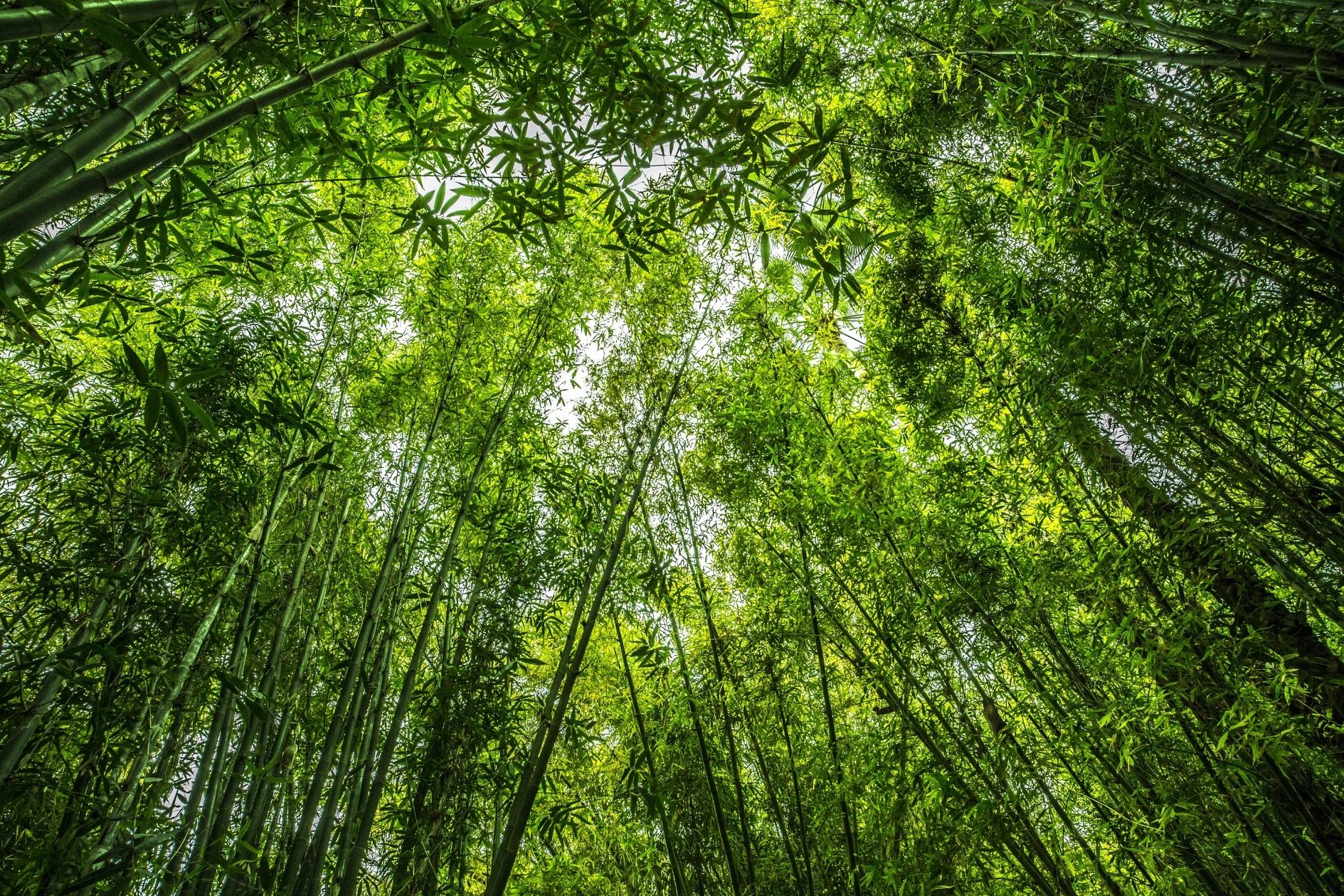
-
Date:
26 Nov 2021 -
Author:
KEHATI
by:
Dr. Ir. Pande Ketut Diah Kencana, MS
Faculty of Agricultural Technology of Udayana University
Bamboo is a multi-purpose plant, well-known to the community, especially the rural community. Bamboo also serves as a vital resource with high economic value. Many bamboos are planted in tropical and sub-tropical areas as clumped plants. The young shoots coming out of their rhizomes or roots will grow into new plants. These new plants will still be together with the old or older plants. Therefore, thick bamboo clumps will be formed, containing many bamboo reeds. Initially, bamboo is only used as a soil-strengthening plant, due to its sturdy root system from its rhizomes, where this root or rhizome unity is hard to be separated. Because of this, people purposely plant bamboos to prevent landslides and floods, and many of them are found on the riversides.
Besides their main objective as conservation, bamboos have their economic benefits, namely can be used as materials for crafting industry, household furniture, buildings, bridges, sources for biomass energy, pulps, plyboo, food ingredients, medicines, charcoals, briquettes, liquid smoke, and social-cultural purposes. This plant belongs to the same family as grass (graminae), and currently has ± 1,600 types across the globe, 160 of them originating from Indonesia.
Bamboos are categorized as non-timber forest products, are planted only 1 (one) time, then selective cutting and ongoing treatment are conducted. If treated well, bamboos can live up to 100 years, as they are resistant to pests. Bamboos are very closely linked to people’s lives, and are known as miracle plants due to their multi-purpose functions, starting from becoming raw materials for housing, clothing, and also food, as well as maintaining the balance of the natural environment, in addition to biodiversity environment. Bamboos are natural resources with many uses. They grow fast, only take 3-4 years, have a strong rooting system, with both fibrous and riding roots that can absorb 90% of rainwater (other plants can only absorb 35-40 %). Bamboos are easy to manage and are suitable for various needs. Their leaves are wide and dense, biologically absorb plenty of CO2, where 1 Ha of bamboo can absorb ± 12 tons of CO2 from the atmosphere, making the air surrounding bamboo gardens clean and healthy.
Currently, the use of bamboo is beginning to increase. Bamboo can serve as a sustainable and perpetual vital resource since there are so many bamboo-based derivative products with high economic value. However, until this time, Indonesia has yet to optimize bamboo as an industrial raw material. One of the issues is investment needs, especially for high-technology products. Besides requiring continuous raw material availability, this needs advanced machines that can only be bought from abroad. But if we look at bamboo’s nature of perpetuity and only needs to be planted once, these should be used as references to design a bamboo-based product industry that is sustainable and environmentally friendly.

Indonesia is home to many bamboo types, around 160 types. However, the fact remains that until today, the population of potentially high economic value bamboo population is not known for certain. This condition is the main source in establishing a bamboo-based industry. Currently, we know how many types of bamboos there are, but without knowing the population of each type, we worry that the feasibility study of a bamboo-based industry is not based on accurate data. Therefore, it is no surprise that Indonesia had experienced a rapid increase in the chopstick industry, but it only lasted for a few years. Afterward, the industry had to shut down one by one due to insufficient raw materials. The same goes for other conditions. Indonesia had a bamboo raw material-based paper factory from significantly large quantities of bamboo, such as Basuki Rahmat in East Java. But, it had to close down its doors due to raw material unavailability. This is the fact in agricultural-based industries in Indonesia, especially the bamboo industry, where the condition at the upstream and downstream is rarely placed in one interconnected and supporting system. More often than not, the condition at the downstream is ready to process the raw materials, while not many know the condition at the upstream. The latter often involves farmers and nature, which is prone to failure due to lack of human resources, lack of attention and mentoring, small land ownership, and natural conditions affecting the bamboo farmers’ production. This condition causes a significant impact on the production downstream.
Of ± 1,600 bamboo species currently known, 160 (10%) of them grow in Indonesia. Around 40 types grow in Bali, one of them is the tabah bamboo (Gigantochloa nigrociliata Buse-Kurz). This type generally grows wild and is found especially at riversides and also as people’s garden fences in Pupuan Tabanan, Bali. The advantage of tabah bamboo is the bamboo sprout can be consumed and is delicious, a little sweet, and very soft. The people of Bali call it tabah because the taste of its bamboo sprout is plain and not bitter.
Even though all bamboos produce bamboo sprouts, not all of them produce delicious ones. All bamboo sprouts contain HCN (Hydrogen Cyanide), which is a poisonous component in varying degrees. Bamboo sprouts with high HCN content are bitter and dangerous to consume. Bamboo sprouts containing HCN below the hazardous level can be consumed as vegetables or mixed with other food. Tabah bamboo, just like any other bamboo that grows in Indonesia, attracts less attention due to its rather small and strong stem, thus is considered to not have an economic value compared to other bamboo types like tali bamboo (G.apus), andong bamboo (G. pseudoarundinacae), and betung bamboo (Dendrocolalamus asper), which are more closely tied to the lives of the Indonesian people.

Photo by PK Diah Kencana
The release of a study that tabah bamboo can produce consumable bamboo sprout, and its potential as an elite vegetable is on par with asparagus and mushroom, prompted excessive demand. The availability of tabah bamboo among the community is very limited, thus making it difficult to turn it into a sustainable and quality industrial raw material. Besides its sprout, the leaves of tabah bamboo have been made into herbal drinks as a source of antioxidant, and the stem can produce charcoals, briquettes, and liquid smoke as materials for fumigation for grade 3 and as food preservatives for grade 1 liquid smoke.
The use of bamboo as a food source plant can be done through its bamboo sprouts and bamboo leaves. Bamboo sprouts can have high economic value if managed and processed well.
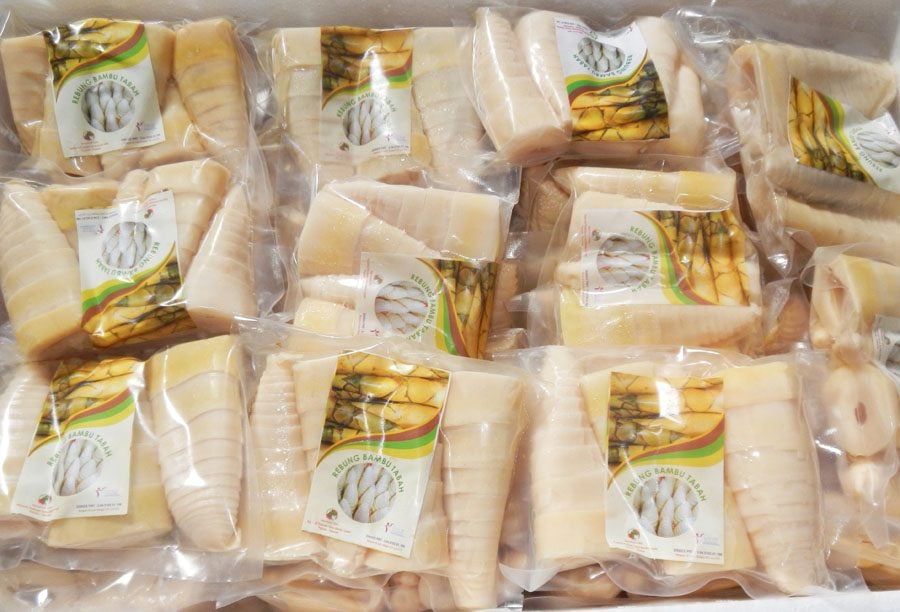 |
 |
Produk rebung bambu dalam kemasan
Foto oleh PK Diah Kencana
In addition to being sold in cans at supermarkets or large stores, bamboo sprouts are also sold at traditional markets. Bamboo sprouts available at traditional markets are offered in various forms, starting from log sprouts, peeled sprouts, and sprouts that have been sliced and ready to be cooked. Bamboo sprouts can only be obtained and processed during the rainy season, while during the dry season, bamboo sprouts will not grow, and during which, we can process bamboo stems and leaves to produce charcoals, active charcoals, briquettes, and liquid smoke.
To anticipate the development of tabah bamboo-based industry, cultivation must continue to be one so that supplies can continue to be provided. Until this time, no communities have performed special cultivation for tabah bamboo, thus we need hints or guidelines on how to do so. This is critical so that people dealing with using tabah bamboo sprouts and other sprout-producing bamboo types are interested to make a business out of it.
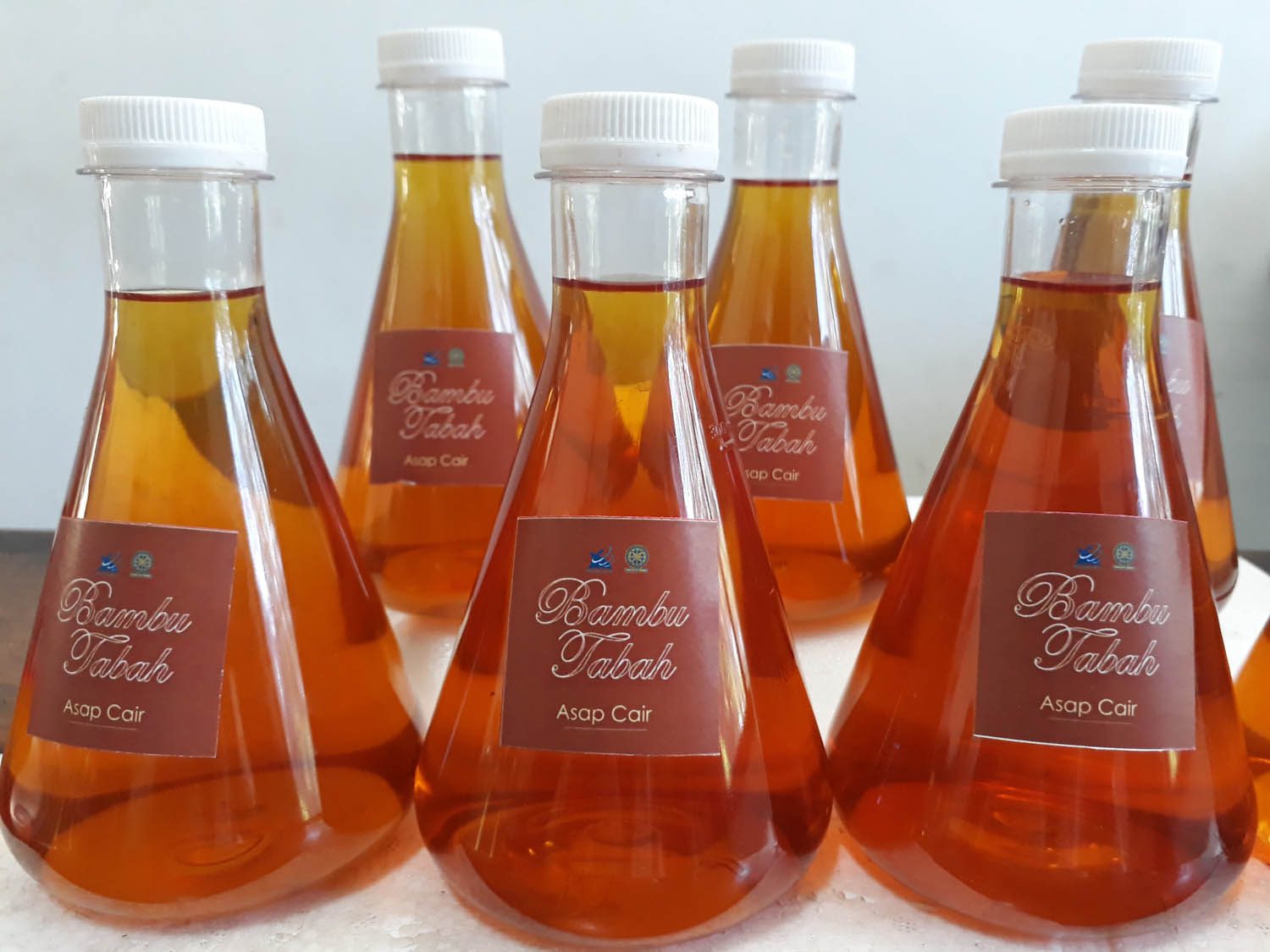 |
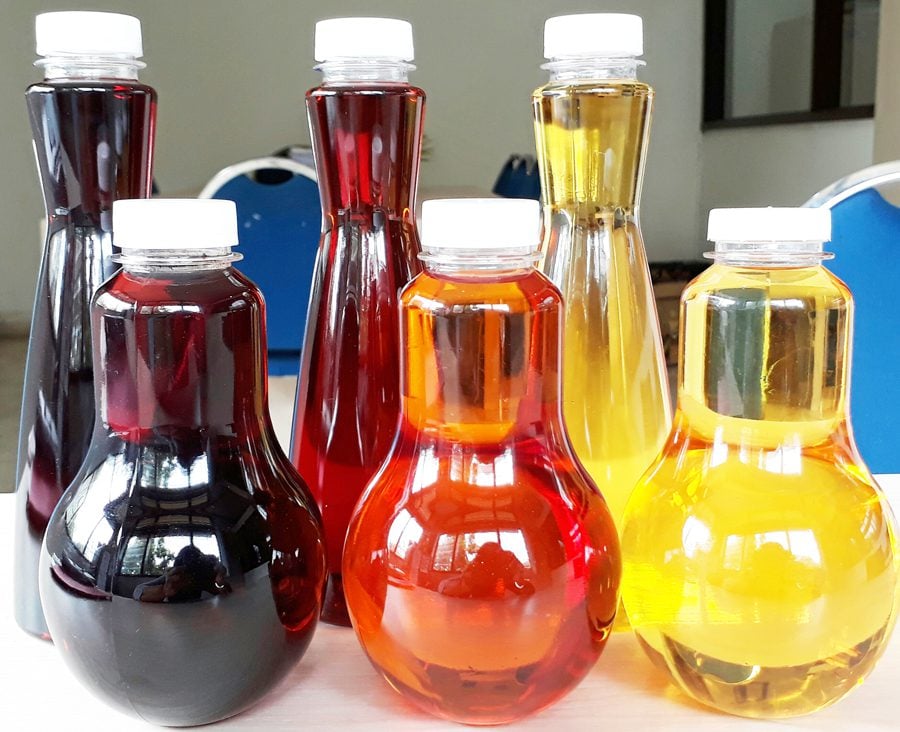 |
Liquid smoke products, processed from bamboo stem
Photo by PK Diah Kencana
The development of a bamboo production center in essence is the initial step to drive the growth of people’s economy in rural areas. Gradually, production activities should be followed by other relevant products, both horizontally and vertically, as well as procuring surrounding services, thus growing the people’s economy.
Developing a production center will be more effective when supported by cross-sectoral or sub-sectoral activities focused and integrated into the selected location. This focused effort should be sustainably done for multi-years to support and enable local farmers and business actors to carry out and perform industrial/crafting activities sustainably with their own abilities.
Developing such production center requires sub-activities, starting from providing inputs, cultivating raw material (bamboos), process technology, marketing, and supporting infrastructure and institutions, integrated from various work areas in control of multiple parties, namely the government, cooperatives, and communities, including private individuals and companies. Therefore, we must develop the design for the development of a multi-year bamboo flagship commodity center.
For this center development to be successful, partially scattered activities and funding must be coordinated and integrated in continuous activity, forming a comprehensive agribusiness system. For this purpose, it is very important to coordinate planning and control from the provincial to the site level, ensuring the focus of various resources and funding to develop such center development. Related to this, the local government as the one in charge of the area and resource owner can play the role of managing the movement to develop this people’s industrial/craft center.
The challenge faced in using bamboo is that it has yet to become a priority for science and technology. Another challenge is limited information, particularly the limited number of researchers and research activities, as well as limited capital. But looking at the positive impact generated from developing bamboo, it is nigh time that this ’green gold’ plant gets prioritized to be considered as an environmentally-friendly organic product source. Bamboo development is a movement, it cannot be done alone, but holistically through the attention given by academics, government, and businesses, with mutual commitment for the sake of hope and prosperity.
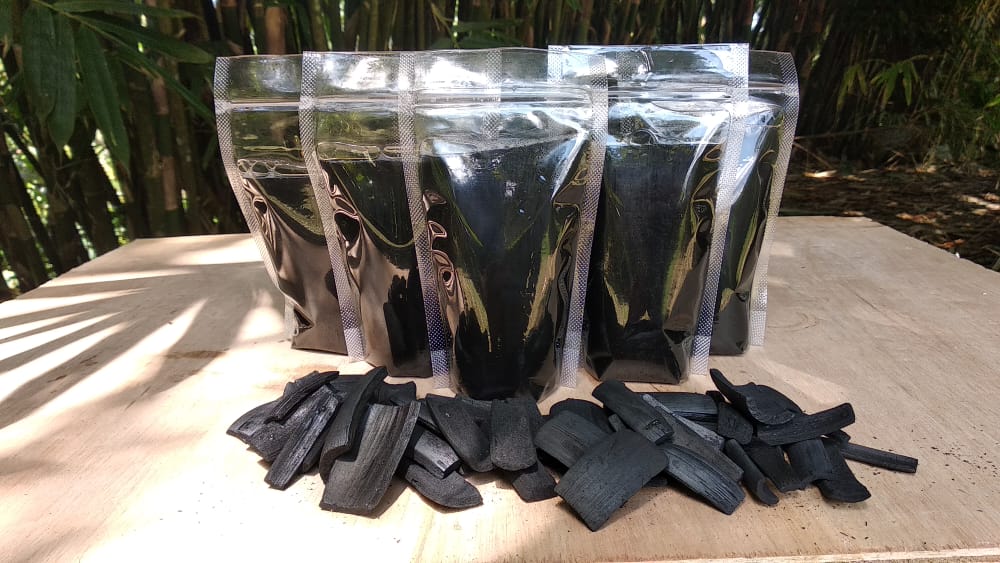 |
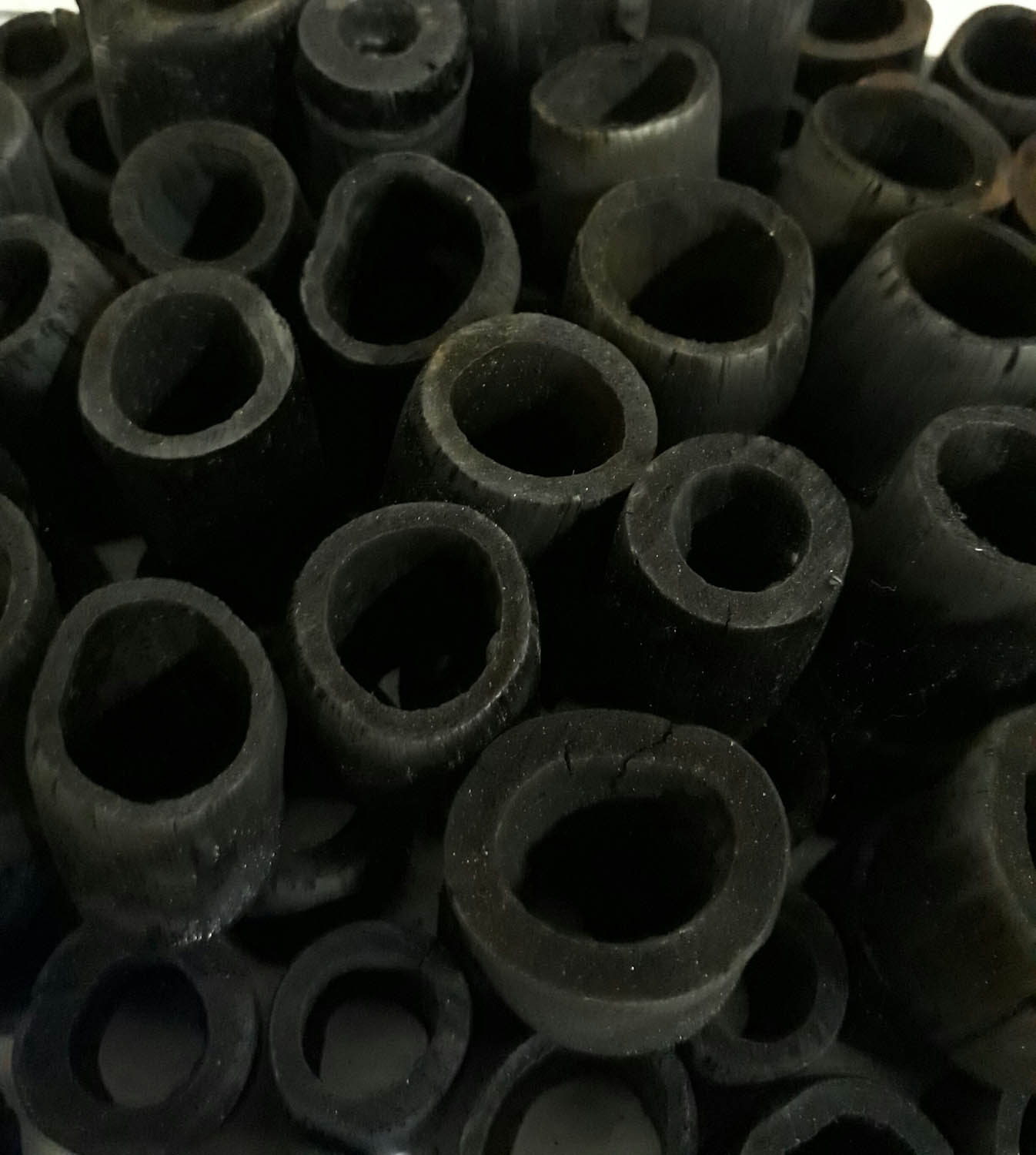 |
[left] Charcoal soap made from tabah bamboo; [right] Tabah bamboo charcoal
Photo oleh PK Diah Kencana
